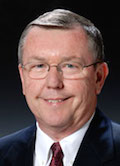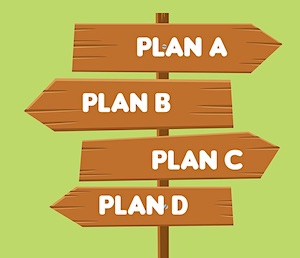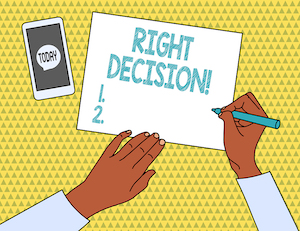How School Leaders Can Handle Decision Fatigue
 By Ronald Williamson and Barbara Blackburn
By Ronald Williamson and Barbara Blackburn
Have you ever noticed how later in the day it gets tougher to make a decision or even more challenging to pick an option from among those presented?
It’s not uncommon to face this dilemma in both our personal and professional lives. It’s a phenomenon called decision fatigue, and psychologists and others have begun to recognize how it impacts the decisions we make.

When decision fatigue impacts one’s professional life, the consequences can have far more impact that a poor dinner choice. School leaders, who hold some of the most complicated jobs in our society, are routinely asked to make decisions – both important and unimportant, complicated and less so – throughout the school day.
The sheer variety of issues faced by school leaders, and the rapid pace at which they are asked to make decisions, mean that those leaders must remain focused and have the mental energy for sound decision-making.
What is Decision Fatigue?
Decision fatigue is a term that describes the deterioration in quality of decisions made by people, particularly later in the day or after we’ve spent considerable time making several complex decisions, one after the other. It acknowledges that a leader may simply deplete their mental energy and “lose their edge.”
Decision fatigue can cloud one’s judgment leading to poor choices. It explains a whole set of undesirable behaviors such as losing focus in meetings, getting angry with colleagues, being impulsive or even making irrational decisions without considering the consequences (Green, 2011).
Implications of Decision Fatigue
People have a finite store of the mental and emotional energy used in making decisions. As their energy is depleted, their ability to handle both routine and complex decision-making declines. This may lead to distinct differences in decisions during different parts of the day.
For example, research inside the Israel criminal justice system found that decisions from tribunals for similar cases were distinctly more punitive later in the day than early in the morning or after a lunch break.
When we experience decision fatigue, we often don’t feel physically tired, so we’re not aware that fatigue is occurring. But declining mental energy has several implications for leaders. Several effects of decision fatigue have been identified:
► Reduced Ability to Make a Choice – Decisions where options exist can be energy-consuming as the decision-maker analyzes both the benefits and costs of each option. People with depleted energy may become reluctant to make trade-offs or seize upon the first option considered.

► Impulse Decisions – Decision fatigue has also be connected to impulsive decisions. Later in the day the fatigued brain looks for shortcuts and acts impulsively rather than expending even more energy to make a decision. A Florida State researcher found a link between impulse decisions and low glucose levels and that when the decision-maker replenished the glucose, they restored their ability to make more effective decisions.
► Impaired Self-Regulation – There is some evidence that decision-making may drain some of a person’s internal resources leaving them less capable of handling other activities. Loewenstein (2003) reported that the ability of decision makers to control impulses in their private lives may stem from the burden of day-to-day decision-making in challenging professional situations.
Avoiding Decision Fatigue
The good news is that while decision fatigue cannot be avoided, researchers have also identified several strategies for minimizing the effects.
✻ Recognize it is a problem – First, don’t minimize the problem or believe that you are immune to the effects. Monitor your behavior and the decisions you make throughout the day (perhaps keep an hourly ‘mental energy diary’ for a week) and plan accordingly.
✻ Plan your day – Once you recognize the effect of decision fatigue, schedule your day so that important meetings or decisions occur early. An alternative is to hold the meeting or make the decision following lunch or a mid-day break.
(A related strategy: Plan the most insignificant decisions the day before. That might be choosing what you will wear or deciding on your lunch for the next day. That way you avoid depleting mental energy before you even get to work.)
✻ Avoid back-to-back meetings – Avoid the tendency to schedule consecutive meetings. Walk the halls, visit a class, check on the physical plant, etc. between meetings so that you can have a short break and recharge your mental energy reserves. Use the time between meetings to get up, move around, and do things that do not require complex decision-making.
✻ Take short mental breaks – As noted earlier, recognize the importance of taking breaks and actually schedule them throughout the day. Pause and let the mind relax and recover. Boost your glucose with a healthy snack, drink plenty of water and breathe deeply.
✻ Sleep on it – If important decisions cannot be made in the morning you may want to resist the urge to decide in the afternoon. “Sleep on it” and reconsider the decision the next morning.
✻ Have clear goals – Decision fatigue is linked to making complex choices from among alternatives. The clearer you are about your goals, the more you’re able to take irrelevant choices off the table and reduce the drain on your mental energy. Clear goals can also make it easier to delegate some decision making to others on your leadership team (who will also need to be alert to decision fatigue).
✻ Avoid distractions – Don’t make decisions when distracted. It’s become increasingly clear in the research that we lessen our effectiveness when we try to juggle multiple tasks at the same time. You can’t avoid social media or email, but you can set specific times to tend to those tasks and leave them alone when making priority decisions.
Decision fatigue won’t go away
We lead busy lives. Even the best leaders and the most astute decision makers are not immune to decision fatigue.
For school leaders who make countless choices big and small about student welfare, school personnel, building management, and family and community communication, it is imperative to understand the dimensions of this inevitable human condition and adopt strategies to minimize the negative impact.
References
Augenblick, N. & Nicholson, S. (2009). Choice Fatigue: The Effect of Making Previous Choices on Decision Making. Stanford Institute for Economic Policy Research.
Green H. (2011). Avoiding the Dreaded Decision Fatigue. Retrieved Jul 21, 2018 from http://www.forbes.com/sites/work-in-progress/2011/09/07/avoiding-the-dreaded-decision-fatigue
Loewenstein, G., Read, D., & Baumeister, R. (Eds.). (2003). Time and Decision: Economic and Psychological Perspectives of Intertemporal Choice. Russell Sage Foundation. Retrieved from http://www.jstor.org/stable/10.7758/9781610443661
Lyengar, S. & Lepper, M. (2000). When choice is demotivating: Can one desire too much of a good thing? Journal of Personality and Social Psychology, 79(6), 995-1006.

Ron works with middle grades schools across the country and is the author of numerous books, including 7 Strategies for Improving Your School (Routledge, 2019). He can be reached through his website.
Barbara R. Blackburn was recently named one of the Top 30 Global Gurus in Education. She is a best-selling author of over 20 books including Advocacy from A to Z written with Robert Blackburn (her dad) and Ron Williamson. An internationally recognized expert in the areas of rigor and motivation, she collaborates with schools and districts for professional development. She can be reached through her website. Follow her on Twitter @BarbBlackburn.
Edutopia has republished portions of this article.




































